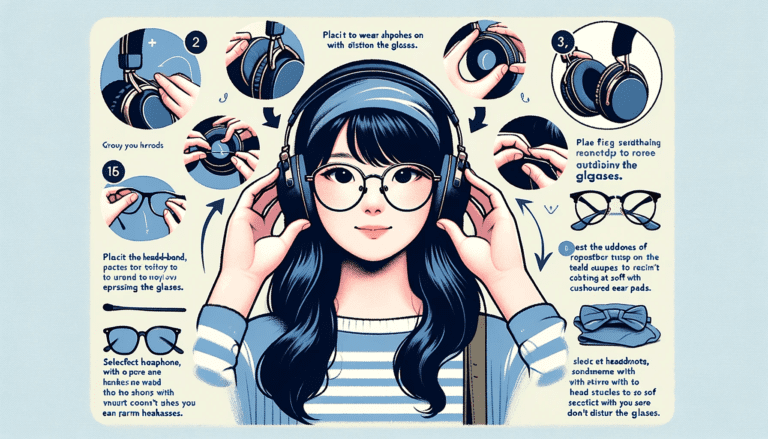Have you ever felt the discomfort of your glasses being pressed against your head while trying to enjoy your favorite tunes? You’re not alone in this struggle. This common dilemma affects countless glasses-wearers who just want to merge their love for music with the necessity of vision correction.
The answer is a resounding yes but with a few considerations. Comfort and compatibility are key. Certain headphone designs are more glasses-friendly, offering features like adjustable headbands and cushioned ear cups to alleviate pressure. It’s not just about whether you can wear them together, but how to do so without sacrificing comfort or sound quality.
But how do you choose the right pair, and what makes some headphones better suited for glasses-wearers than others? In the following article, we delve into expert opinions and user experiences to guide you through selecting the perfect headphones for your needs.
So, are you ready to discover the ultimate way to enjoy music without compromising on comfort? Let’s explore the world of glasses-compatible headphones together!
Exploring the Feasibility and Comfort of This Combination
While it might initially seem like an impossible feat to comfortably wear both headphones and glasses simultaneously, there are certainly ways to mitigate the challenges and find a balance between functionality and comfort. Understanding the nuances of different types of headphones – specifically over-ear versus in-ear – will help shed light on potential solutions suited to your needs. Over-ear headphones offer cushioned ear cups that envelop your ears for immersive sound experiences.
However, when paired with glasses, these ear cups may press against your frames’ arms, leading to discomfort or even pain. The key lies in finding a headphone model with adjustable headbands that can accommodate the additional space required by your glasses’ temples.
This ensures that the headband sits comfortably over your head without exerting excessive pressure on your temples. On the other hand, in-ear headphones provide an alternative option for those seeking a hassle-free experience when wearing glasses.
By their design, these earbuds do not directly contact your frames, eliminating any potential discomfort caused by pressure points. However, it is crucial to ensure a proper fit to prevent dislodging or accidentally pushing against your glasses frames.
Ultimately, the feasibility and comfort of wearing headphones over glasses rely on various factors such as the type of headphones you choose and how they interact with your specific glasses’ design. Additionally, taking into account your preferences for audio quality and comfort will help guide you toward finding the perfect combination that harmonizes both worlds seamlessly. You may read also Why Do Autistic People Wear Headphones
Understanding the Challenges
Potential discomfort caused by pressure points on the temples
When it comes to wearing headphones over glasses, one of the primary challenges is the potential discomfort caused by pressure points on the temples. The temple area is where the arms of your glasses rest, and when combined with the pressure from headphone ear cups, it can create an unwelcome sensation.
This pressure can lead to headaches or even soreness as you listen to your favorite tunes or engage in intense gaming sessions. It’s essential to consider this factor before deciding on a particular headphone-glasses combination.
Interference between headphone ear cups and glass frames
Another challenge that comes with wearing headphones over glasses is the interference between headphone ear cups and glasses frames. Depending on the size and design of your glasses, you may find that they clash with larger-sized ear cups.
Not only can this result in an uncomfortable fit, but it may also cause your glasses to shift or even fall off if they’re not securely positioned. It’s crucial to find a balance between headphones that offer good audio quality without compromising comfort when paired with your specific style of glasses.
Finding a balance between audio quality and glass fit
Finding a comfortable balance between audio quality and glasses fit is key for an enjoyable listening experience. While some headphones provide exceptional sound clarity, they might not be compatible with all types of eyewear.
On the other hand, choosing headphones solely based on how well they accommodate your glasses could mean sacrificing audio performance. Striking this equilibrium requires careful consideration of both factors.
One way to navigate this challenge is by opting for adjustable headbands on over-ear headphones, allowing you to customize their fit according to your head shape and prevent excessive pressure on the temples. Additionally, selecting lightweight materials like plastic or carbon fiber for both frames and headphone construction can alleviate discomfort caused by prolonged use.
Remember, finding the ideal balance may require some trial and error, as individual head and glass shapes vary greatly. Understanding the challenges associated with wearing headphones over glasses is crucial for finding a comfortable and enjoyable audio experience.
The potential discomfort caused by pressure points on the temples can be mitigated by selecting headphones with adjustable headbands and lightweight materials. Additionally, interference between headphone ear cups and glass frames can be avoided by carefully considering the compatibility between the two.
Striking a balance between audio quality and glasses fit requires a combination of personal preferences and experimentation. By being mindful of these challenges, you can make an informed decision when choosing headphones to wear over your glasses.
Over-Ear Headphones vs In-Ear Headphones
Comparing pros and cons of over-ear headphones with glasses
When it comes to wearing headphones over glasses, the choice between over-ear and in-ear headphones plays a crucial role. Over-ear headphones are known for their cushioned ear cups that provide added comfort during long listening sessions. The soft padding creates a barrier between your temples and the pressure points, reducing discomfort.
However, one downside to consider is the potential interference between the headphone ear cups and the arms of your glasses. Depending on the design of both your glasses frames and headphones, they might uncomfortably push against each other, irritating.
Cushioned ear cups for added comfort but may interfere with glasses arms
One of the significant advantages of wearing over-ear headphones with glasses is their cushioned ear cups. They envelop your ears in soft material, providing a comfortable listening experience even during extended periods.
The cushioning acts as a barrier between your temples and the headphone’s pressure points, minimizing discomfort caused by wearing glasses. However, it’s essential to be aware that certain designs of over-ear headphones might interfere with glasses arms.
Bulky or wide ear cups can put excessive pressure on the sides of your head where the temple tips rest. This can lead to discomfort or even cause your glasses to slip off your face when adjusting or removing your headphones.
Adjustable headbands for better fit, reducing pressure on temples
A notable advantage of many over-ear headphone models is their adjustable headbands. These bands can be extended or contracted to fit various head sizes comfortably. By finding an optimal fit for your head shape and size, you can reduce pressure on your temples caused by both glasses frames and headphones.
The adjustable feature allows you to customize how tightly or loosely you wear the headphones, ensuring a snug fit without exerting excessive pressure on your temples. This, in turn, enhances comfort and reduces the likelihood of headaches or soreness.
Evaluating in-ear headphones as an alternative option
For those seeking an alternative option to over-ear headphones, in-ear headphones are worth considering. In-ear headphones have the advantage of not directly contacting your glasses frames.
By inserting small earbuds into your ear canals, you eliminate any discomfort caused by overlapping pressure points. To ensure optimal comfort with in-ear headphones and glasses, it’s crucial to find the right fit.
Ill-fitting earbuds can dislodge easily or push against your glasses frames when moving or adjusting them. Therefore, paying attention to the size and shape of the ear tips is essential.
Experimenting with different sizes provided with the headphones or investing in custom-fit ear tips can significantly improve both comfort and audio quality. By weighing the pros and cons of both over-ear and in-ear headphones, you can make an informed decision based on your personal preferences for comfort and audio experience while wearing glasses. You may read the guide on Why Do DJs Wear Headphones
Tips for Wearing Headphones with Glasses
Opting for lightweight headphone models to minimize pressure
Wearing headphones over glasses can sometimes lead to discomfort, especially if you have heavy or bulky headphones. To alleviate this issue, it’s advisable to opt for lightweight headphone models that put less pressure on your temples.
Look for headphones made from materials like plastic or carbon fiber, as they tend to be lighter compared to metal or other heavier substances. By choosing a lighter pair of headphones, you can enjoy your music without feeling like your glasses are weighing you down.
Adjusting headphone fit and positioning for optimal comfort
Another crucial aspect of wearing headphones comfortably with glasses is adjusting the fit and positioning of the headband and ear cups. If your headphones have an adjustable headband, loosen the tension slightly to reduce pressure on your temples.
This adjustment helps in avoiding headaches and soreness caused by prolonged contact between the headphone band and your glasses arms. When it comes to positioning the ear cups around your frames, be mindful of how they interact with each other.
Carefully place the ear cups over your ears while ensuring that they don’t press on the sides of your glasses frames or cause any discomfort. Adjusting the angle and position of the ear cups can make a world of difference in terms of comfort.
Avoid bulky designs that can add unnecessary weight
While some people prefer larger and more robust headphone designs for audio quality reasons, these bulkier designs may not be ideal when wearing glasses simultaneously. Bulky headphones tend to add unnecessary weight on top of your frames, leading to discomfort and potential headaches after prolonged use. Opting for sleeker models can help prevent these issues by reducing unnecessary pressure on both temples.
It’s important to strike a balance between audio quality and practicality when choosing headphones if you wear glasses regularly. Consider looking for headphones that offer a balance between lightweight design and excellent sound performance.
With advances in technology, there are now plenty of options available that provide fantastic audio while still being comfortable for glasses wearers. Wearing headphones with glasses is indeed possible with a few thoughtful considerations.
Opting for lightweight headphone models made from materials like plastic or carbon fiber can minimize pressure on your temples. Adjusting the fit and positioning of the headband and ear cups also plays a crucial role in ensuring optimal comfort.
Additionally, avoiding bulky designs can help prevent unnecessary weight on your glasses frames. By following these tips, you can enjoy your favorite tunes without sacrificing comfort or compromising your vision when wearing glasses. You may check also Why Do Musicians Wear Headphones
Special Considerations for Different Glasses Types
Prescription Glasses:
Wearing headphones over prescription glasses can present some unique challenges. One potential concern is the impact on lens clarity due to the pressure exerted by the headphone arms on the frames. Depending on the quality and resilience of your lenses, this pressure may cause slight distortions or blurriness in your vision.
It is advisable to consult with an optician who can provide specific guidance based on your prescription and glasses material. They may suggest alternative frame designs or materials that can minimize any potential negative effects.
Sunglasses:
For those sunny days when you want to enjoy music while protecting your eyes, wearing sunglasses with headphones can be a bit trickier. One challenge is finding a comfortable fit without compromising either the sunglasses’ stability or headphone functionality.
The combination of bulky sunglasses frames and headphone ear cups can create discomfort and instability when worn together. Additionally, sunglasses with thicker frames might restrict the proper positioning of over-ear headphones, impacting both comfort and sound quality.
Considering alternative options, individuals may choose to invest in specialized audio sunglasses that combine UV protection with built-in speakers or bone conduction technology. These innovative devices allow you to listen to music while keeping your ears free from obstruction and maintaining clear visibility through sunglass lenses. You may read the guide on Why Do Podcasters Wear Headphones
Conclusion
Wearing headphones over glasses requires careful consideration of various factors such as frame design, headphone type, and personal comfort preferences. While it may pose certain challenges like discomfort from pressure points or interference between ear cups and frames, there are ways to overcome these obstacles for an enjoyable listening experience without sacrificing visual clarity or convenience. By opting for lightweight headphone models with adjustable headbands, users can alleviate pressure on their temples while ensuring a secure fit over their glasses.
In-ear headphones also offer an alternative option by avoiding direct contact with glasses altogether. For those with prescription glasses, seeking advice from opticians can provide valuable insights into potential lens distortions and recommendations for suitable frame materials.
Despite these considerations, the ability to wear headphones comfortably over glasses is certainly achievable with a bit of experimentation and finding the right combination that works for you. So go ahead, put on your favorite frames, slip on those headphones, and indulge in a world of music or podcasts while embracing your unique style.







